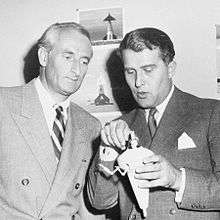Heinz Haber
Heinz Haber (May 15, 1913 – February 13, 1990) was a German physicist and science writer who primarily became known for his TV programs and books about physics and environmental subjects. His lucid style of explaining hard science has frequently been imitated by later popular science presenters in Germany.

Biography
After studying physics in Leipzig, Heidelberg and Berlin and obtaining his doctorate, Haber served in World War II for the German Luftwaffe as a reconnaissance aviator until 1942. He returned to the Kaiser-Wilhelm-Institut für Physik, where he headed a small Potsdam-based division constructing a diffraction spectrograph.[2]
After the end of the war, Haber — as well as several other Germans involved in military research like Wernher von Braun — was targeted by the Operation Paperclip with the aim of denying scientific expertise and knowledge to the Soviet Union and bringing researchers and scientists to the United States; Ultimately this operation resulted in a considerable contribution to the development of NASA.[3] Haber at first stayed in the American occupied zone of Germany and lectured at Heidelberg. However, in 1946, he emigrated to the United States and joined the USAF School of Aviation Medicine at Randolph Air Force Base. Together with fellow German Hubertus Strughold, he and his brother Dr. Fritz Haber (April 3, 1912 – August 21, 1998) made pioneering research into space medicine in the late 1940s.[4][5][6] The brothers proposed parabolic flights for simulating weightlessness.[7]
In 1952, he became associate physicist at UCLA; in the 1950s, Haber eventually became the chief scientific consultant to Walt Disney productions. He later co-hosted Disney’s Man in Space with von Braun. When the Eisenhower administration asked Disney to produce a show championing the civilian use of nuclear power, Heinz Haber was given the assignment. He hosted the Disney broadcast called Our Friend the Atom and wrote a popular children’s book with the same title, both of which explained nuclear fission and fusion in simple terms. General Dynamics, a manufacturer of nuclear reactors, sponsored Our Friend the Atom and the nuclear submarine ride at Disneyland’s Tomorrowland.[8]
In the 1960s and 1970s, he was known in Germany as a popular science spokesperson and wrote magazine columns and numerous books and presented his own TV programs like Professor Haber experimentiert, Das Mathematische Kabinett, Unser blauer Planet, Stirbt unser blauer Planet?, Professor Haber berichtet, and WAS IST WAS mit Professor Haber. He was founding editor of the German science magazine Bild der Wissenschaft from 1964 to 1990. His memorable experiments included one where the onset of a nuclear chain reaction was simulated with hundreds of mousetraps, each one having been loaded with two ping pong balls.[9]
Heinz Haber had two children, Kai (born 1943) and Cathleen (born 1945), from his first marriage, and a third child, Marc (born 1969), from the second. His first wife Anneliese lives in Tucson, Arizona, his second wife Irmgard in Hamburg, Germany.
References
- This image is a detail from a larger photograph, which may be seen at the article on Willy Ley.
- James, Jeremiah; Steinhauser, Thomas; Hoffmann, Dieter; Bretislav, Friedrich (2011). One hundred years at the intersection of chemistry and physics: the Fritz Haber Institute of the Max Planck Society, 1911-2011. Berlin: De Gruyter. pp. 117, 127. ISBN 978-3110239539.
- Linda Hunt. (May 23, 1987). "NASA's Nazis". Literature of the Holocaust. http://www.english.upenn.edu/~afilreis/Holocaust/nasa-nazis.html. Linda Hunt. Secret Agenda: The United States Government, Nazi Scientists, and Project Paperclip, 1945 to 1990. (New York: St.Martin's Press, 1991).
- Buettner, K. J., & Haber, H. (1952). The aeropause. Science. 115: 656-657.
- Editor. (19 November 1951). Science: The Unfriendly Aeropause. Time. New York.
- White, C.S. & Benson, O.O. (1952). Physics and medicine of the upper atmosphere: a study of the aeropause. University of New Mexico Press, 1952.
- Haber, Fritz; Haber, Heinz (1950). "Possible methods of producing the gravity-free state for medical research". Journal of Aviation Medicine. 21 (5): 395–400. PMID 14778792. Summary of the article: Campbell, Mark R. (2009). "Classics in space medicine. Possible methods of producing the gravity-free state for medical research". Aviation, Space, and Environmental Medicine. 80 (12): 1077. doi:10.3357/ASEM.26010.2009. PMID 20027862.
- Eric Schlosser. Fast Food Nation: The Dark Side of the All-American Meal. (Houghton Mifflin Harcourt, 2001) pg. 39.
- In Walt Disney's film Our Friend the Atom, Haber is the science presenter (see ). While explaining a chain reaction, the camera travels over a field of mousetraps, all ready to close and throw two ping pong balls in the process (see a resume in "Archived copy". Archived from the original on 2004-12-28. Retrieved 2009-02-05.CS1 maint: archived copy as title (link)).
Further reading
- Linda Hunt (1991), Secret Agenda: The United States Government, Nazi Scientists, and Project Paperclip, New York: St. Martin's.
- Eric Schlosser (2001), Fast Food Nation: The Dark Side of the All-American Meal, Boston: Houghton Mifflin Harcourt.
- Manfred Gross (2013), "Sterne, Menschen und Atome - Zum 100. Geburtstag von Heinz Haber" (German), Mannheim. Available at Karl-Friedrich-Gymnasium Mannheim, Stadtarchiv Mannheim - Institut für Stadtgeschichte, Planetarium Mannheim, Freundeskreis Planetarium Mannheim e.V.
External links
- VERHEXT — a 1960s puzzle game by Heinz Haber based on hexiamonds (Archived March 3, 2016, at the Wayback Machine)